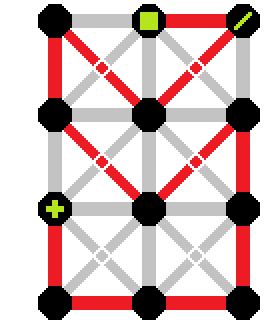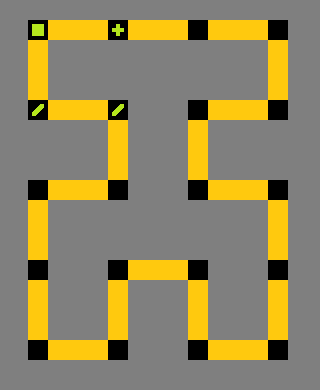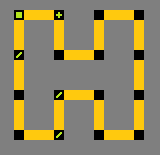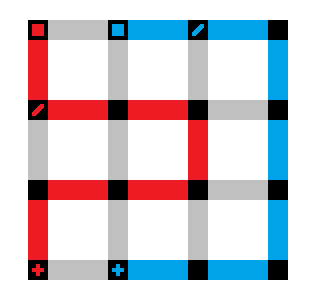Exhibit #1
Types of Unicursal Mazes.
The following exhibit displays different types of unicursal mazes, some quite common while others are far more experimental in nature. Let us take a moment to appreciate them for what they are.

This is a fine example of a determined (sometimes referred to as a pre-determined) maze. It's technical name is 0404-008-23. It's called a determined maze because the starting point and the end point are already placed onto the field of points before the path is created. You'll note the high number of corner points that the path possesses as well as the fact that it is symmetrical. A very lovely maze, indeed.

Here is an example of an undetermined maze. It's technical name is 0404-000-234134. Undetermined mazes have a starting point but no end point when the path is created. The end point is where, quite honestly, the path ends. Thus, you can see that it has far more decision points than it's determined counterpart above. Undetermined mazes are traditionally painted blue to distinguish themselves, naturally, from the determined mazes (which are red).

Above is an example of a diagonal maze. It's diagonal because, as you can clearly see, the segments can go in any one of eight directions. This particular example is called 0304-00M-36. Before we go on, let me clarify that this is a "determined diagonal" maze, in that the start and end point are on the field before the path is created. That's an important fact because this starting and end point combination would be impossible on a conventional maze where the segments can only go in the four cardinal directions (north, south, east & west). The type of arrangement of start point and end point on a maze such as this one is called a "1st degree" diagonal maze. It is called as such since the start and end point should be possible to complete using only the four cardinal directions but it isn't, given the nature of the 3x4 field. Diagonal mazes don't need their own individual color; You can tell it's diagonal by the angle of the segments alone.

Looped mazes are those mazes that are capable of becoming a loop, since their start point and end points may be attached by a single segment, as shown here. This example is called 0405-01-323. The segments are colored a shade of gold and so the background is a dark gray to make the gold color stand out. This looped maze is a modified determined maze; undetermined looped mazes also exist. Below is one such example (in pink) with it's determined equivalent (in gold) beside it.



Obstructed mazes are ones where some points may not be entered (they are "obstructed"). This example is called 040402-04-05-2. I'll be the first to admit that there are not a lot of obstructed mazes that have been constructed just yet. That's our fault and we need to perform a better job at producing more of them. Clearly, one can tell in this example that there are two obstructions (the red "X"s). Just as with looped mazes, obstructed mazes are modified determined mazes. Again, it's certainly feasible to have undetermined obstructed mazes but they haven't been a priority of research just yet. Obstructed mazes are colored green although, to be honest, they are easily identifiable by the obstructions on the field itself.

I have to almost apologize for the inclusion of this type of maze in our exhibit. However, if we are being fair to our patrons, we did express that some of these mazes are experimental in nature and this one, undoubtedly, fits that description quite well. As you can see, there are two starting and end points in this field, One path is red and the other blue. We have no idea currently where this type of maze might fit into our research one day but this is just one example of the many unconventional styles of mazes that we have imagined during our time.

What you see before is not so much an unicursal maze in the classical sense but rather a diagram for revealing the ordered rules for path generation. Without elaborating upon the details, for which there are many, there are rules for unicursal path generation. These rules may be revealed through two methods of path generation, ordered & unordered. Ordered rule generation takes place when each direction from a given point is evaluated upon it's merits for continuing the path until the first acceptable direction is revealed. Unordered rule generation takes place when each direction from a given point is evaluated upon it's merits for continuing the path regardless of how many acceptable directions from that point there are.
If that sounds very intimidating to understand all at once... You aren't alone. This exhibit is not the time or place to explain rule generation with clarity. For the casual observer, know simply that this example, known as 0204-02-1342 demonstrates an example of an ordered maze and you can see the first four rules (most definitely not the only rules, I can assure you) of unicursal maze generation. Very briefly, they are: 1). Don't move off of the field of points, 2). Don't enter the end point until you have entered all of the other points first, 3). Don't re-enter a point that you have already entered and 4). When you have the ability to enter a non-exit point that has only one possible exit, you must enter it. Those are abbreviated definitions, to be certain, but they should provide a sufficient explanation for what is occurring in that diagram.